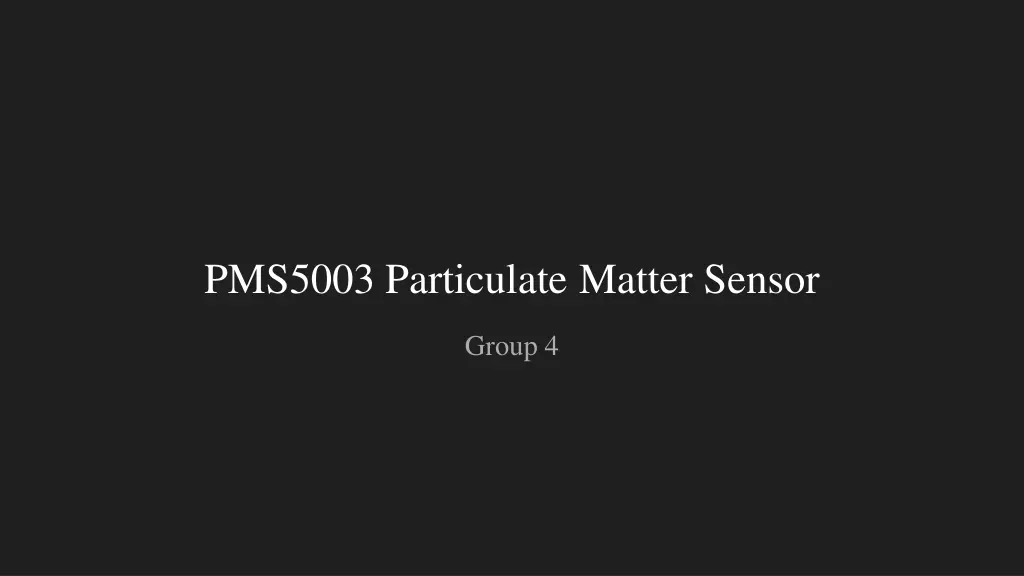
Optical Monitoring of Particulate Matter Sensors
Understand how optical sensors like PMS5003, Adafruit PM25AQI, and other PM sensors work using light and diffraction theories to measure particle concentration and size. Explore the accuracy, experiment setups, and models like MIE theory and Fraunhofer diffraction theory.
Download Presentation

Please find below an Image/Link to download the presentation.
The content on the website is provided AS IS for your information and personal use only. It may not be sold, licensed, or shared on other websites without obtaining consent from the author. If you encounter any issues during the download, it is possible that the publisher has removed the file from their server.
You are allowed to download the files provided on this website for personal or commercial use, subject to the condition that they are used lawfully. All files are the property of their respective owners.
The content on the website is provided AS IS for your information and personal use only. It may not be sold, licensed, or shared on other websites without obtaining consent from the author.
E N D
Presentation Transcript
Accuracy PMS5003 particulate diameter [0.3 m, 10 m] Counting efficiency: 50% [0.3 m, 0.5 m] 98% (0.5 m, 10 m]
An Experiment No Solder Solder
Adafruit PM25AQI zip library Test code available Check if the way you connected the sensor is correct in the code (not I2C) This will give concentration and amount of particles of different sizes Regular air Above a lit candle Above the candle after it was blown out, some smoke
General Overview Laser goes into the air channel, light scatters, the data goes through a filter, and then the microprocessor uses MIE theory to calculate concentration ( g/m3) and number of particles MIE theory is a collection of solutions and methods of Maxwell s equations that describe scattering
Fraunhofer diffraction theory Models the diffraction when the diffraction pattern is viewed at long distance from the diffracting object. Equation:
Other Particulate Matter Sensors Infrared obstruction - simplest but not accurate. IR shown through chamber filled with particles, and light is blocked by particles. The amount of light blocked relates to the number of particles. We don t know what else can block the light : accuracy takes a hit
Optical Monitoring of Particulate Matter How it works: A beam of light (IR) is emitted from the sensor. If a particle comes across it, some light is reflected back, registering a pulse for that duration. If air is moving at constant speed, length of this pulse can be used to estimate particle size.
Other Particulate Matter Sensors PM1006K LED Particle Sensor: This sensor uses the optical sensing method to detect the variation of particle size in the air (between 0.3 mand 10 m). An infrared light emitting diode and an optoelectronic sensor are optically arranged inside and dust concentration is measured by detecting the intensity of scattered light, outputting real time concentration via a calibrated algorithm.
Other Particulate Matter Sensors Beta Attenuation Mass Monitoring - Wide range of particles. Heavy and Expensive. Particles stick to a paper stuck between a source and a detector of beta radiation. Beta radiation is absorbed by particles and residual is measured. Accuracy is much higher than IR based sensors.
Other Particulate Matter Sensors NOx-sensors Measure current flow between electrodes in a sensor using amperometric principle. One working electrode and one reference electrode
Other Particulate Matter Sensors Soot-sensors - limited application to measure soot e.g. from a car. Measure resistance of a film deposited on sensor. How to continuously measure? Resetting the film without manual intervention
Applications Why detect particulate matter? Microscopic solid or liquid particles suspended in the air. Can be categorized into different types based on their size like PM 2.5, PM 10, etc. Also known as particle pollution can be harmful to one s health and thus needs to be monitored.
Applications Heavily used in auto industry to monitor the particulate matter or soot getting accumulated in the Diesel Particulate Filter. Used as a failure detector for Diesel Particulate Filter as it may cause excess PM emissions. Government agencies, hospitals and other research organizations use such monitors to measure air quality. Used in various other types of filtering devices such as air purifiers.
Sources [1] https://forums.adafruit.com/viewtopic.php?f=48&t=136528&p=767725#p767725 [2] https://cdn-learn.adafruit.com/downloads/pdf/pm25-air-quality-sensor.pdf [3] https://www.aqmd.gov/docs/default-source/aq-spec/resources-page/plantower-pms5003-manual_v2-3.pdf [4] https://en.gassensor.com.cn/ParticulateMatterSensor/info_itemid_105.html?gclid=CjwKCAjw3pWDBhB3Ei wAV1c5rEQm67D1s0bWUoqBrcGWZX3j0k1vbr_uk23LxFyH8iFgxta-0uAgXBoChDoQAvD_BwE#box1 [5] https://publiclab.org/wiki/optical-pm
